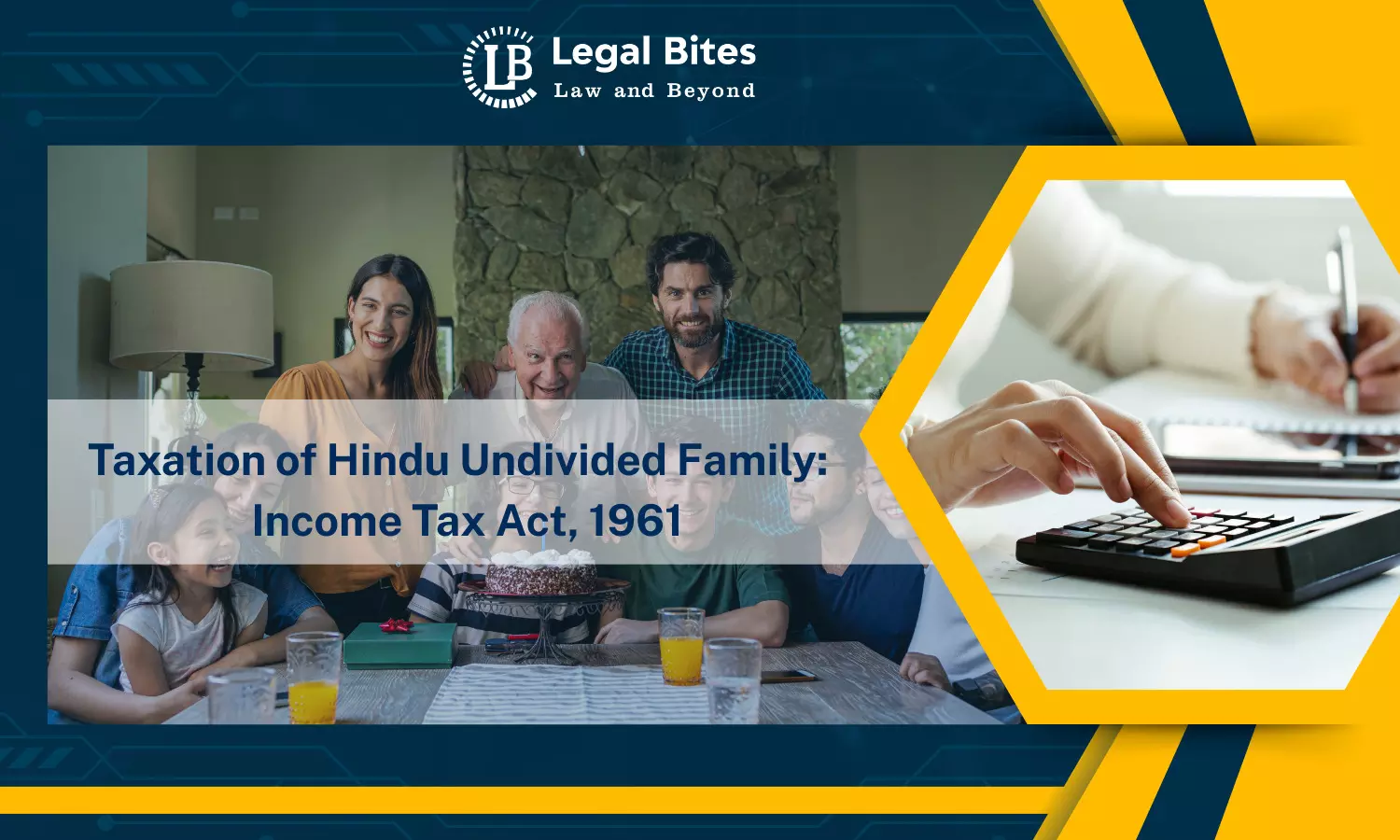Taxation of Hindu Undivided Family: Legal Aspects under the Income Tax Act, 1961
This article examines the legal aspects of HUF taxation, including its formation, taxability, benefits and judicial interpretations.

The Hindu Undivided Family (HUF) is a unique institution recognised under Indian personal law and taxation framework. Under the Income Tax Act, 1961, the HUF is treated as a separate person for assessment and taxation. This recognition offers tax planning opportunities and carries legal obligations distinct from those of an individual taxpayer. The structure of HUF has both economic and cultural roots, and the law governing its taxation has evolved significantly through statutes and...
The Hindu Undivided Family (HUF) is a unique institution recognised under Indian personal law and taxation framework. Under the Income Tax Act, 1961, the HUF is treated as a separate person for assessment and taxation. This recognition offers tax planning opportunities and carries legal obligations distinct from those of an individual taxpayer. The structure of HUF has both economic and cultural roots, and the law governing its taxation has evolved significantly through statutes and judicial precedents.
Concept and Recognition of HUF
Meaning of HUF
A Hindu Undivided Family (HUF) is a family comprising all persons lineally descended from a common ancestor, including their wives and unmarried daughters. It is governed by Hindu Law and is applicable to Hindus, Buddhists, Jains, and Sikhs.
Legal Status under Income Tax Law
Section 2(31) of the Income Tax Act, 1961 defines “person” to include an HUF. Therefore, HUF is liable to pay income tax and file returns in its own capacity, separate from its members.
Formation of HUF for Tax Purposes
An HUF can be formed:
- By inheritance of ancestral property
- Through gifts received by HUF from relatives
- Via the partition of a larger HUF
- Through joint income generation from property or business.
To recognise the HUF under the Income Tax Act:
- A separate PAN must be obtained in the name of HUF
- A bank account should be opened in the HUF's name
- An official declaration of HUF creation should be made (preferably on stamp paper)
Taxability and Assessment
Separate Taxable Entity
Under the Income Tax Act, HUF is treated as a separate entity and taxed independently of its members.
Sources of HUF Income
Income earned by the HUF can include:
- Business or professional income (if the business is family-owned)
- Rental income from HUF-owned property
- Capital gains from sale of HUF assets
- Interest or dividend from HUF investments
Note: Personal income of members from employment or professional services does not form part of HUF income.
Computation of HUF Income
HUF is taxed as per the slab rates applicable to individuals. The income is computed after considering all deductions and exemptions allowed under the Act.
Deductions and Exemptions Available to HUF
| Provision | Benefit |
|---|---|
| Section 80C | Deduction up to ₹1.5 lakh for LIC, PPF, ELSS, etc. if paid from HUF account |
| Section 80D | Deduction for health insurance premium of members |
| Section 80G | Donations to approved funds and charitable institutions |
| Section 24(b) | Interest on home loan up to ₹2 lakh |
These deductions are available only if the expenditure is incurred by the HUF, not individual members.
Tax Return Filing and Compliance
ITR Forms
- ITR-2: If HUF has no business income
- ITR-3: If HUF has business or professional income
Books of Accounts and Audit
- If total turnover exceeds ₹1 crore (or ₹10 crore if 95% transactions are digital), audit under Section 44AB is mandatory.
- Maintenance of books under Section 44AA may also apply.
Partition of HUF: Meaning and Scope
Partition of a Hindu Undivided Family (HUF) refers to the division of joint family property among its members.
- If the property allows physical division, shares are distributed accordingly.
- If physical division isn’t feasible, partition takes place in a manner suitable to the nature of the property.
Assessment after Partition [Section 171]
Once assessed as a HUF, income continues to be taxed as such until a coparcener claims partition.
The claim must be made before the relevant assessment year.
The Assessing Officer (AO) must:
- Serve notice to family members
- Conduct an inquiry
- Record a finding about the occurrence and date of partition
Tax Implication:
- Income from the start of the year to the partition date is taxed as HUF income.
- Income from partitioned property after that is taxed as individual income (or as income of a new HUF if the recipient forms one with spouse/children).
Types of Partition
1. Total Partition
- Entire joint property is divided among all coparceners.
- The HUF ceases to exist.
2. Partial Partition
- Partial as to persons: Some coparceners separate; others remain united.
- Partial as to property: Only part of the joint estate is divided, while the rest remains undivided.
Legal Effect of Partial Partition [Section 171(9)]
After 31 December 1978, partial partitions are not recognised for tax purposes if:
- Partition occurred post-1978, and
- The HUF was previously assessed under the Income Tax Act
Consequences:
- The family continues to be assessed as an unpartitioned HUF
- All members are jointly and severally liable for tax, penalty, interest, or fine
- Individual liability is determined by the share received in such partition
Clubbing of Income [Section 64(2)]
If an individual transfers assets to the HUF without adequate consideration, any income from such assets is taxed in the hands of the transferor.
Illustration: Mr. X gifts ₹10 lakh to HUF. The HUF invests and earns ₹1 lakh annually. This ₹1 lakh will be clubbed in Mr. X’s income.
Karta and Duties
The Karta is the eldest male/female coparcener managing HUF affairs.
Duties of Karta:
- Filing income tax returns
- Managing HUF assets
- Representing HUF in legal matters
HUF and Capital Gains
HUF can invest capital gains in:
- Capital Gain from Sale of Residential House (Section 54)
- Capital Gain Exemption on Sale of Non-Residential Assets if Invested in a Residential House (Section 54F)
- Capital Gain Exemption on Investment in Bonds (Section 54EC)
These exemptions are available to HUFs just like individuals.
Judicial Interpretations
[1] Surjit Lal Chhabda v. Commissioner of Income Tax (1975)
The Supreme Court held that when a Hindu male throws his self-acquired property into the family hotchpotch, it does not automatically become Hindu Undivided Family (HUF) property for tax purposes if there is no son or male coparcener. The Court clarified that a joint family can exist with a man, his wife, and daughter, but without a coparcener (like a son), the property retains its character as individual property. Hence, income from such property continues to be taxed as the individual’s income and not as HUF income, even if a formal declaration of blending was made.
[2] Vineeta Sharma v. Rakesh Sharma (2020)
The Supreme Court of India held that daughters have equal coparcenary rights in Hindu Undivided Family (HUF) property by birth, regardless of whether the father was alive on the date of the 2005 amendment to the Hindu Succession Act. Overruling previous conflicting decisions, the Court clarified that the 2005 amendment confers substantive rights and is retroactive in effect, ensuring gender equality in ancestral property inheritance under Hindu law.
Advantages of HUF in Tax Planning
- HUF is a separate tax entity—additional basic exemption
- Can claim deductions independently
- Ideal for succession planning
- Helps in asset consolidation under the family unit
Conclusion
The Hindu Undivided Family, a deeply rooted Indian concept, offers considerable tax advantages if used lawfully and appropriately. While the HUF can be a powerful tax planning vehicle, the scope for misuse has led to scrutiny by tax authorities. A clear understanding of legal and fiscal implications is essential for proper utilisation.
Key Changes Affecting HUFs in Budget 2025
No tax on income up to ₹12 lakh (₹12.75 lakh for salaried with standard deduction); simplified slab structure benefits the middle class.
|
|---|
References
- Income Tax Act, 1961
- Budget 2025-2026
- Everything You Need to Know About Hindu Undivided Families (HUF), Available Here
- Surjit Lal Chhabda v. CIT, AIR 1975 SC 109
- Vineeta Sharma v. Rakesh Sharma (2020) SC 3717

Ajay Kulkarni
Ajay Kulkarni completed his undergraduate studies at the University of Texas and earned his LL.B. from the Faculty of Law, University of Delhi. A qualified Company Secretary (CS), he specializes in Taxation Law with a keen interest in the evolving landscape of Indian and international tax regulations.
